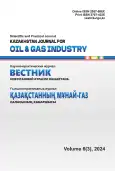Testing the functionality of OLGA software for determining optimal oil transport modes to prevent solid particle deposition
- Authors: Yerlepessov M.U.1, Zaitsev O.I.2, Yermekov A.A.1, Amirov S.K.1, Urbisinov Z.S.1
-
Affiliations:
- Branch of KMG Engineering LLP KazNIPImunaigaz
- Branch of Schlumberger Logelco Inc in the Republic of Kazakhstan
- Issue: Vol 6, No 3 (2024)
- Pages: 82-93
- Section: Транспорт нефти и газа
- URL: https://journal-vniispk.ru/2707-4226/article/view/266875
- DOI: https://doi.org/10.54859/kjogi108728
- ID: 266875
Cite item
Full Text
Abstract
Background: During operation, all mechanical impurities entering the collector through the flow lines settle at the bottom due to a decrease in flow velocity. This leads to a reduction in the capacity of the pipeline network, increased pressure, and premature equipment wear. To address this issue it is essential to understand the dynamics and intensity of sludge formation at the bottom of the pipeline.
Aim: Evaluate the functionality and efficiency of the dynamic multiphase flow simulator in addressing challenges related to the transport of borehole fluid containing solid particles.
Materials and methods: To build a mathematical simulation of multiphase flow with solid particles using OLGA specialised software, we selected one of the oil gathering lines in field N, with a diameter of 159х10 mm and a length of 1600 m, as the study object. This oil gathering line collects production from 16 wells. The OLGA simulator was used to model the process and measure flow parameters with different particle diameters, predicting the dynamics of variables such as time-varying flow velocities, fluid composition, temperatures, and particulate deposition. For a flow with a particle diameter of 104 µm, active precipitation occurs at flow rates between 200 and 300 m³/day. At flow rates of 400 m³/day and above, the velocity is sufficient to carry the particles without significant accumulation in the pipeline.
Results: The software enabled the calculation of the dynamic system for different solid particle diameters in multiphase flow, addressing the challenge of evaluating the dynamics of solid phase accumulation in the pipeline and determining the fluid flow velocity required to prevent sludge formation. The software is suitable for implementing simulation modelling to develop technical solutions that minimise the risks of solid particle deposition in oil gathering pipelines during the operation of on-shore infrastructure facilities.
Conclusion: The software enabled the calculation of the dynamic system for different solid particle diameters in multiphase flow, addressing the challenge of evaluating the dynamics of solid phase accumulation in the pipeline and determining the fluid flow velocity required to prevent sludge formation. The software is suitable for implementing simulation modelling to develop technical solutions that minimise the risks of solid particle deposition in oil gathering pipelines during the operation of on-shore infrastructure facilities.
Full Text
##article.viewOnOriginalSite##About the authors
Murat U. Yerlepessov
Branch of KMG Engineering LLP KazNIPImunaigaz
Author for correspondence.
Email: m.yerlepessov@kmge.kz
ORCID iD: 0009-0007-8581-2786
Kazakhstan, Aktau
Oleg I. Zaitsev
Branch of Schlumberger Logelco Inc in the Republic of Kazakhstan
Email: OZaitcev2@slb.com
ORCID iD: 0009-0002-0443-655X
Kazakhstan, Atyrau
Abay A. Yermekov
Branch of KMG Engineering LLP KazNIPImunaigaz
Email: A.Yermekov@kmge.kz
ORCID iD: 0009-0003-2130-2489
Kazakhstan, Aktau
Sain K. Amirov
Branch of KMG Engineering LLP KazNIPImunaigaz
Email: s.amirov@kmge.kz
ORCID iD: 0009-0005-7771-5535
Kazakhstan, Aktau
Zhuginis S. Urbisinov
Branch of KMG Engineering LLP KazNIPImunaigaz
Email: Zh.Urbissinov@kmge.kz
ORCID iD: 0009-0008-9723-5565
Kazakhstan, Aktau
References
- Tao Y, Chen J, Liu J. Application and Practice of Integrated Sand Control Technology in Shallow Heavy Oil Reservoirs in Kazakhstan. SPE Annual Caspian Technical Conference; Nov 15–17, 2022; Astana, Kazakhstan. Available from: https://onepetro.org/SPECTCE/proceedings-abstract/22CTC/1-22CTC/514602.
- Taherifard A, Elistratov VV. Numerical Simulation of Erosion in a Pipe Under a Multi-Phase Oil and Gas Flow. Proceedings of the VNIIG. 2023;307:16–28. (In Russ.).
- Solnordal CB, Wong CY, Boulanger J. An experimental and numerical analysis of erosion caused by sand pneumatically conveyed through a standard pipe elbow. Wear. 2015;336:43-57. doi: 10.1016/j.wear.2015.04.017.
- Pereira GC, de Souza FJ, de Moro Martins DA. Numerical prediction of the erosion due to particles in elbows. Powder Technology. 2014;261:105-117. doi: 10.1016/j.powtec.2014.04.033.
- Zhang Y, Reuterfors EP, McLaury BS, et al. Comparison of computed and measured particle velocities and erosion in water and air flows. Wear. 2007;263(1–6):330–338. doi: 10.1016/j.wear.2006.12.048.
- Najmi K., McLaury B.S., Shirazi S.A., Cremaschi S. Low concentration sand transport in multiphase viscous horizontal pipes: An experimental study and modeling guideline. AIChE J. 2016;62:1821–1833. doi: 10.1002/aic.15131.
- Wicks M. Transport of solids at low concentration in horizontal pipes. Advances in Solid-Liquid Flow in Pipes and Its Application; March 4–6, 1968; Pennsylvania, PA. Available from: https://trid.trb.org/view/19654.
- al-Mutahar F. Modeling of Critical Deposition Velocity of Sand in Horizontal and Inclined Pipes : MSc Thesis. Tulsa : Department of Mechanical Engineering, The University of Tulsa, 2006.
- OLGA Flow Assurance. Version 2017. Guide and exercises. Schlumberger, 2023.
- Yermekov AA, Baspayeva AT, Amirov SK. Application of simulation to optimize the oil-gathering system of the “N” oil field. Kazakhstan journal for oil & gas industry. 2023;5(1):94–102. doi: 10.54859/kjogi108599.
Supplementary files



















